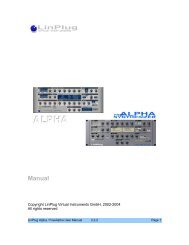SaxLab Manual - LinPlug Virtual Instruments
SaxLab Manual - LinPlug Virtual Instruments
SaxLab Manual - LinPlug Virtual Instruments
Create successful ePaper yourself
Turn your PDF publications into a flip-book with our unique Google optimized e-Paper software.
Growl Control Source: The Growl Control Source is used to set the type of<br />
MIDI control change message that controls the “growl” component of the<br />
instrument’s sound. Three options are available: Velo (Velocity), BC (Breath<br />
Controller) and AT (Aftertouch). Only one type of MIDI control change<br />
message can be used at a time.<br />
Growl Control Response Curve: This setting workl just like already described<br />
for the Amp, Brightness and Reverb Control Response Curve.<br />
Growl Maximum Depth: The Growl Maximum Depth control sets the maximum<br />
volume level of the growl component of the instrument's sound. Note that this<br />
control works in conjunction with the Growl Deviation control (described<br />
below). If the Growl Deviation control is set to 0, then the level of the growl<br />
component of the instrument's sound is determined by the setting of the Growl<br />
Maximum Depth control. If the Growl Deviation control is set to a value other<br />
than 0, then the level of the growl component of the instrument's sound will<br />
randomly vary between 0 and the current value of the Growl Deviation control<br />
for each note that is played.<br />
DEV (Growl Deviation): The DEV (Growl Deviation) control is used to set a<br />
degree of randomisation in the “growl” component of the instrument's sound.<br />
Increasing the DEV (Growl Deviation) control will introduce more random<br />
variation in the amount and tone of the growl component of the instrument's<br />
sound from note to note.<br />
Three MIDI controllers are available for modulating <strong>SaxLab</strong> 2’s various<br />
Performance parameters. These are: Velo (Velocity), BC (Breath Controller)<br />
and AT (Aftertouch). Each controller works in a slightly different way. Note<br />
that only one type of MIDI control change message can be used for each<br />
Performance Control at a time.<br />
Velo (Velocity): All MIDI controllers have the ability to trigger a note. This is<br />
usually done by transmitting a MIDI Note-On message. Note-On messages<br />
consist of three bytes: a Status byte and two Data bytes. The second Data<br />
byte contains the velocity at which the key was pressed. In most cases, key<br />
velocity is used to determine the loudness of the synthesized sound. Note that<br />
only one Note-On message is transmitted for each note that is played.<br />
BC (Breath Controller): MIDI Wind controllers typically transmit breath<br />
pressure information as MIDI Breath Control messages. Breath Controller<br />
messages consist of three bytes: a Status byte and two Data bytes. The<br />
message's first Data byte defines the type of Control Change message (in this<br />
case, Breath Control), which has a value of 0x02. The second Data byte<br />
determines the current output value of the Breath Controller.<br />
Note that new Breath Controller messages are transmitted whenever the<br />
controller's input changes, so that Breath Controller messages can vary over<br />
the duration of a note. Also note that MIDI keyboards normally do not transmit<br />
Breath Controller messages, however it is usually possible to reassign the<br />
output of other MIDI controllers (such as the Mod Wheel) so that they transmit<br />
MIDI Breath Controller messages.<br />
<strong>LinPlug</strong> <strong>SaxLab</strong> User Guide 2.0.3<br />
22












